Supernova in the Pinwheel Galaxy. Supernova 2023ixf, in M101 off the Big Dipper, is still in view of amateur telescopes. It's fading slowly; as of June 26th was magnitude 11.9, down from its May 25th peak of 11.1. It's also slightly "reddening" — actually, yellowing.
Supernovae usually stay bright for weeks — sometimes with surprise variations, though this one has shown none yet. See Bright Supernova Blazes in M101, the Pinwheel Galaxy, with charts and comparison magnitudes.
FRIDAY, JUNE 23
■ This is the time of year when the two brightest stars of summer, Arcturus and Vega, are about equally high overhead not too long after dark: Arcturus toward the southwest, Vega toward the east.
Arcturus and Vega are 37 and 25 light-years away, respectively. They represent the two commonest types of naked-eye star: Arcturus is a yellow-orange giant of spectral type K, and Vega is a white A main-sequence star. They're 150 and 50 times brighter than the Sun, respectively — which, combined with their nearness, is why they dominate the sky.
SATURDAY, JUNE 24
■ The Moon, nearly first quarter, shines after dark about a fist-width under Denebola, Leo's tail-tip star.
■ On the eastern side of the sky, the Summer Triangle holds sway after dark. Its top star is Vega, the brightest on that entire side of the celestial dome. The brightest star to Vega's lower left is Deneb. Farther to Vega's lower right is Altair.
SUNDAY, JUNE 25
■ First-quarter Moon tonight (exactly first-quarter at 3:50 a.m. Monday morning EDT). Now Denebola is about a fist and a half to the Moon's upper right. Brighter Spica is about two fists to the Moon's left.
MONDAY, JUNE 26
■ This evening the Moon shines between Spica to its left and fainter Gamma Virginis (Porrima) closer to its right, as shown below (for North America). Gamma Vir is a lovely, equal-brightness double star for telescopes, separation 3.3 arcseconds this year. The pair is oriented almost north-south.
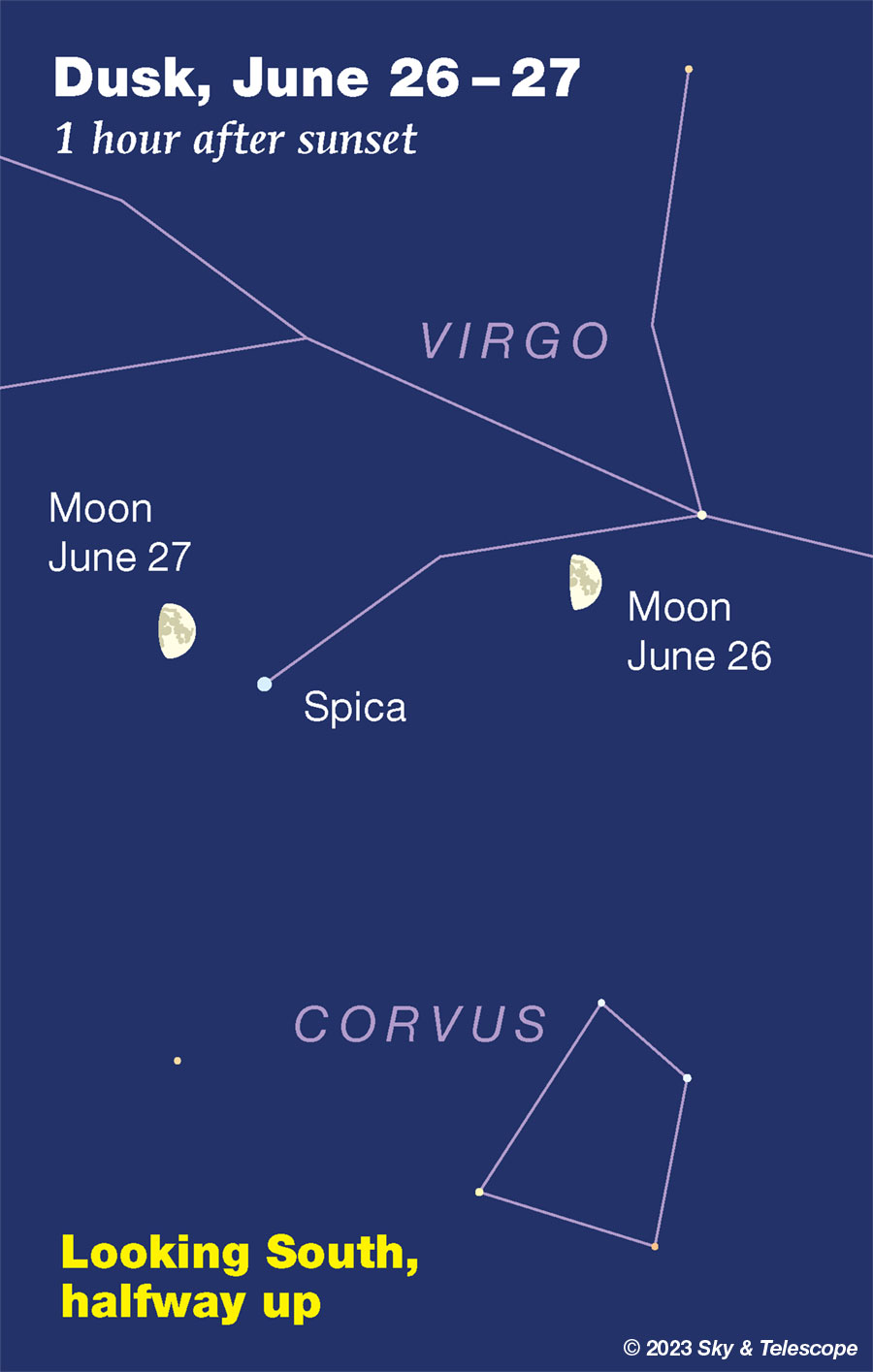
TUESDAY, JUNE 27
■ The central stars of the little constellation Lyra, forming a small triangle and parallelogram, dangle lower right from bright Vega high in the east. The two brightest stars of this pattern, after Vega, are the two forming the bottom of the parallelogram: Beta and Gamma Lyrae. They're currently lined up vertically. Beta is the one on top.
Beta Lyrae is an eclipsing binary star. Compare it to Gamma whenever you look up at Lyra. Normally Beta is only a trace dimmer than Gamma. Eventually, however, you'll catch Beta when it is quite obviously dimmer than usual.
WEDNESDAY JUNE 28
■ This is the time of year when, right after dark, the dim Little Dipper floats straight up from Polaris, the end of its handle, like a helium balloon on a string escaped from some evening backyard party. Through moonlight or light pollution, however, all you may see of the Little Dipper are Polaris at its bottom and Kochab, the lip of the Little Dipper's bowl, at the top. The rest of its stars are 3rd to 5th magnitude.
THURSDAY, JUNE 29
■ The Moon tonight shines about two thirds of the way from Spica, way off on its right, to Antares waiting for it on its left.
FRIDAY, JUNE 30
■ The Moon shines among the stars of upper Scorpius. The brightest of these is orange Antares about 2° or 3° to the Moon's lower left (for North America). Next brightest is Delta Scorpii, farther to the Moon's upper right. Binoculars help through the moonlight and summer haze.
■ Mars and Venus are now at their minimum separation for this apparition, 3.6° apart, as shown below. Mars will remain in low twilight view for more than a month to come. Venus will drop away faster.
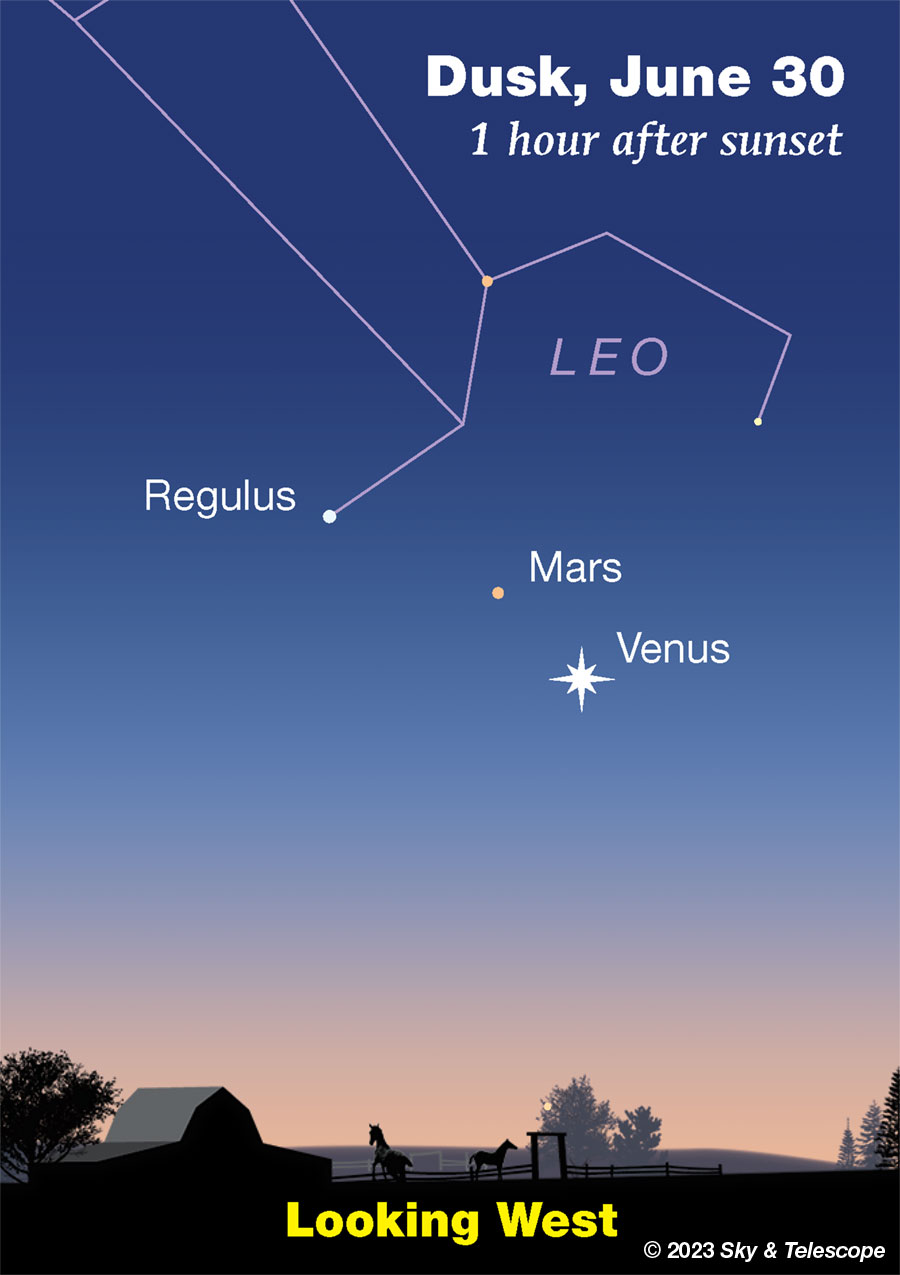
Whenever Mars moves into the same general part of the sky as vivid Venus, Mars dwindles into a puny, pathetic little thing. Why does this always happen?
It's because 1) Venus is an inner planet, so we can never see it very far from the Sun in our sky, and 2) Mars is an outer planet, so when we see it anywhere near Venus — i.e. not very far from the Sun — it's on the far side of its orbit from us, nearly as distant as it can ever get.
SATURDAY, JULY 1
■ Now the Moon shines midway between upper Scorpius to its west and the Sagittarius Teapot to its east.
■ To casual starwatchers or those with an obstructed northern view, Cassiopeia in July may sound as wrong as Christmas in July. But already Cas has passed its lowest evening position of the year and is gradually gaining altitude in preparation for the coming fall and winter. Look for its flattened W shape low in the north-northeast and no longer quite level.
SUNDAY, JULY 2
■ The Moon, just a day from full, shines inside the Sagittarius Teapot (for North America). Use binoculars to piece out the Teapot through the moonlight. Note: The Teapot is about twice the width of a typical binocular's field of view, so expect to sweep around a bit.
This Week's Planet Roundup
Mercury is out of sight in the glare of the Sun.
Venus (magnitude –4.7, in Leo under the Sickle) is the brilliant "Evening Star" in the west in twilight. It's getting lower day by day, now setting soon after dark.
In a telescope Venus is a lovely, dazzling white crescent, thinning and enlarging. It's now about 30 arcseconds from pole to pole and one-third sunlit. Get your telescope on it as early after sunset as you can, or better yet, in the afternoon blue sky when it's higher in steadier seeing. Watch Venus change daily. It will continue to swell in diameter and thin in phase as it drops lower and finally becomes lost from sight in mid- to late July.
Mars (magnitude 1.7, also in Leo) glows weakly a little to Venus's upper left. They've been approaching each other for months, but now they stop. Mars and Venus reach a minimum separation of 3.6° on June 30th, then they'll start to draw apart again as Venus plunges down toward the sunset. This is called a quasi-conjunction, because they don't actually pass each other although they do get within 5° of each other.
Look for Regulus, a bit brighter than Mars, somewhat farther upper left.
In a telescope Mars is just a tiny little blob 4.2 arcseconds in diameter, since it's on the far side of its orbit from us. And it's a small planet to begin with.
Jupiter (magnitude –2.2, in Aries) is the bright "star" in the east before and during early dawn.
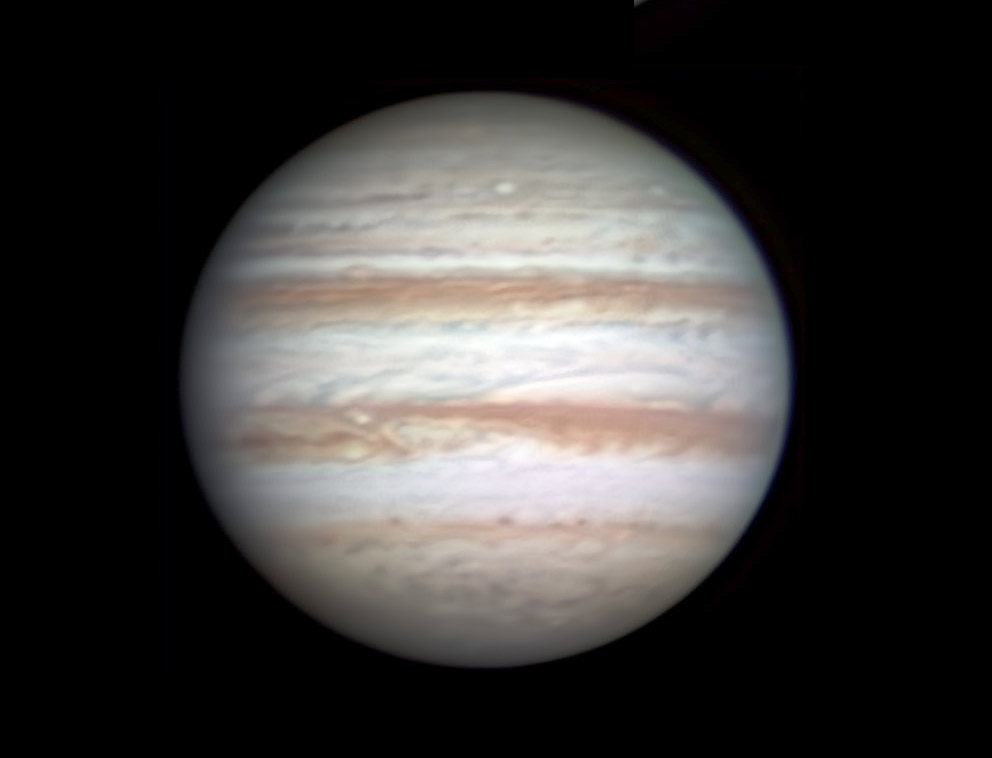
Saturn (magnitude +0.9, in dim Aquarius) rises around 11 p.m. or midnight. By the beginning of dawn it's in steadiest telescopic view high in the south-southeast.
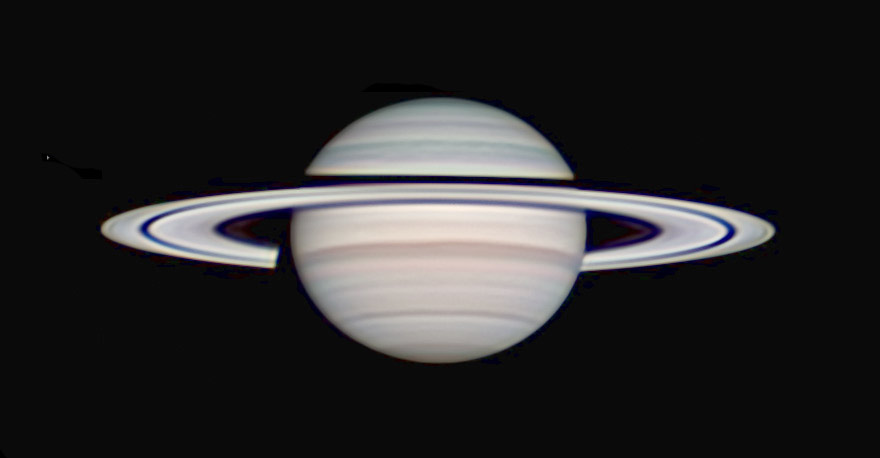
Uranus, magnitude 5.8 in Aries, is low in the east-northeast by the beginning of dawn.
Neptune, magnitude 7.9 at the Aquarius-Pisces border, is high in the southeast before dawn begins. It's 20° east along the ecliptic from Saturn.
All descriptions that relate to your horizon — including the words up, down, right, and left — are written for the world's mid-northern latitudes. Descriptions and graphics that also depend on longitude (mainly Moon positions) are for North America.
Eastern Daylight Time (EDT) is Universal Time minus 4 hours. UT is sometimes called UTC, GMT, or Z time.
Want to become a better astronomer? Learn your way around the constellations. They're the key to locating everything fainter and deeper to hunt with binoculars or a telescope.
This is an outdoor nature hobby. For a more detailed constellation guide covering the whole evening sky, use the big monthly map in the center of each issue of Sky & Telescope, the essential magazine of astronomy.
Once you get a telescope, to put it to good use you'll need a much more detailed, large-scale sky atlas (set of charts). The basic standard is the Pocket Sky Atlas (in either the original or Jumbo Edition), which shows all stars to magnitude 7.6.
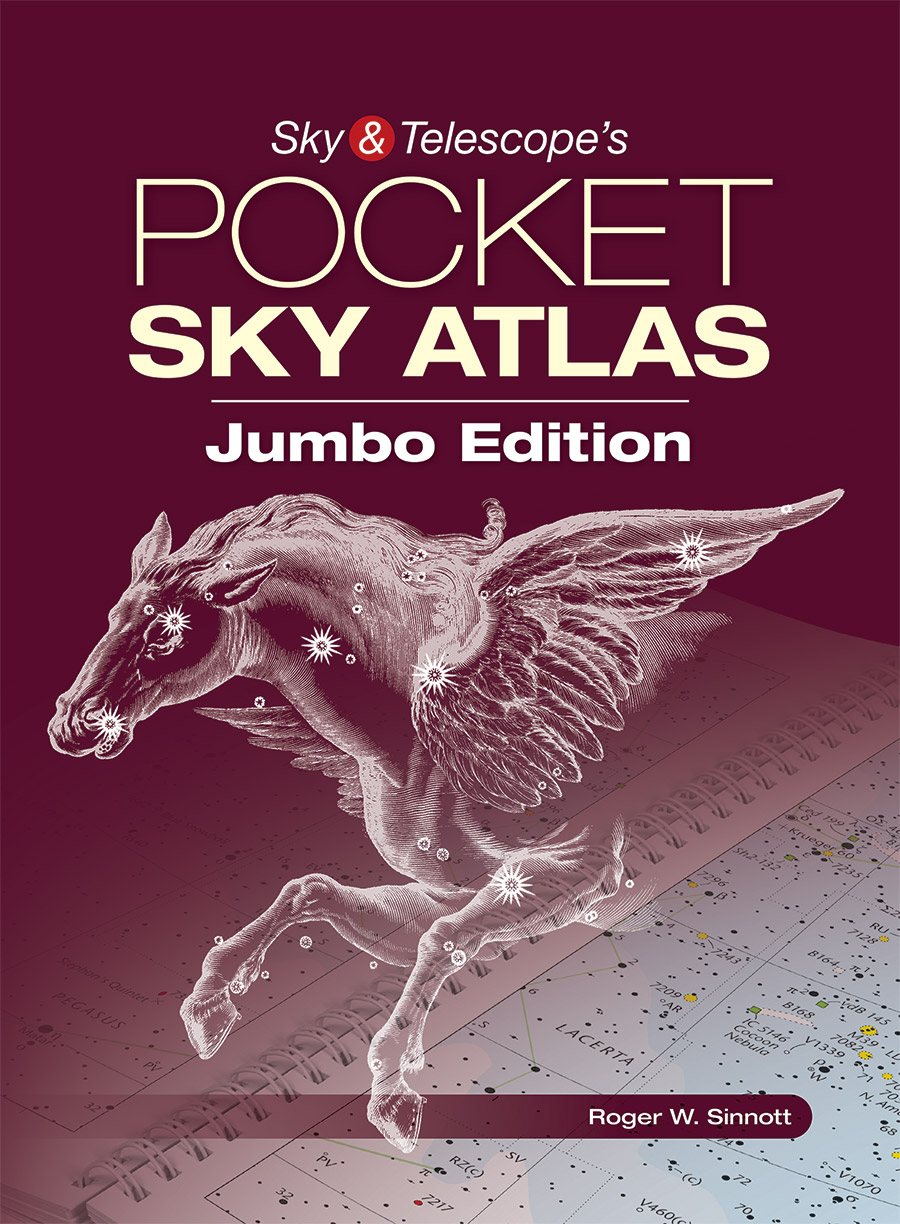
Next up is the larger and deeper Sky Atlas 2000.0, plotting stars to magnitude 8.5; nearly three times as many. The next up, once you know your way around, are the even larger Interstellarum atlas (stars to magnitude 9.5) or Uranometria 2000.0 (stars to mag 9.75). And be sure to read How to Use a Star Chart with a Telescope. It applies just as much to charts on your phone or tablet as to charts on paper.
You'll also want a good deep-sky guidebook. A beloved old classic is the three-volume Burnham's Celestial Handbook. An impressive more modern one is the big Night Sky Observer's Guide set (2+ volumes) by Kepple and Sanner.
Can a computerized telescope replace charts? Not for beginners, I don't think, and not on mounts and tripods that are less than top-quality mechanically. And as Terence Dickinson and Alan Dyer say in their Backyard Astronomer's Guide, "A full appreciation of the universe cannot come without developing the skills to find things in the sky and understanding how the sky works. This knowledge comes only by spending time under the stars with star maps in hand."
![]() Audio sky tour. Out under the evening sky with your
Audio sky tour. Out under the evening sky with your
earbuds in place, listen to Kelly Beatty's monthly
podcast tour of the heavens above. It's free.
"The dangers of not thinking clearly are much greater now than ever before. It's not that there's something new in our way of thinking, it's that credulous and confused thinking can be much more lethal in ways it was never before."
— Carl Sagan, 1996
"Facts are stubborn things."
— John Adams, 1770
 4
4









Comments
mary beth
June 27, 2023 at 4:43 pm
It’s been extremely hot in Texas. The late evenings and nights have been remarkably nice. We have had clear skies and a refreshing breeze. Antares is twinkling so beautifully high in the southeast.looked very orange Sunday evening. Spica crossed the meridian before 8:30 PM. Arcturus is blazing at the zenith. Of course, Venus is still stealing the show but it’s also nice to see Mars and Regulus nearby. Vega is up early, but usually I am inside by the time the rest of the triangle is visible over the trees. Hope others are enjoying the summer stars! Oh and the moon- it seems brighter than ever! My imagination or is there a possibility that the June moon receives more sunlight??
You must be logged in to post a comment.
Rod
June 28, 2023 at 7:23 am
Nice mary beth. My last evening viewing was 01-June. Mostly clouds, light rain, t-storms in the evenings and now likely more smoke from Canda coming today 🙂 Days are sunny, but t-storms keep popping up and visiting later in the day. I am enjoying more swimming, indoor for the mornings, and outdoors for the evenings as weather permits. Not much stargazing at my end for June. At night in July and August, I prefer to be at the pool and not in the fields 🙂
You must be logged in to post a comment.
Rod
June 29, 2023 at 6:20 am
I went out near 0500 this morning and looked at Jupiter in Aries with unaided eyes. Very dim, Canada smoke over the area-again, not good for stargazing or observing.
You must be logged in to post a comment.
mary beth
June 29, 2023 at 11:49 pm
Sorry to hear of the stargazing has been so minimal, I can’t wait till that smoke is gone so you can enjoy Scorpio and other summer celestial gems. It sounds like you are still having fun swimming and enjoying hot weather activities. Do you have fun plans for Fourth of July?
The waxing gibbous moon was so bright and beautiful tonight. The moon will be near Antares Friday night. I’m really looking forward to that conjunction.
A few weeks ago, at least five satellites were passing along the same path right after dark, and I thought I was seeing shooting stars, but it was just each satellite momentarily appearing and disappearing, it was quite a sight! I was able to figure out what happened using Stellarium. (Hat tip to Rod).
You must be logged in to post a comment.
You must be logged in to post a comment.